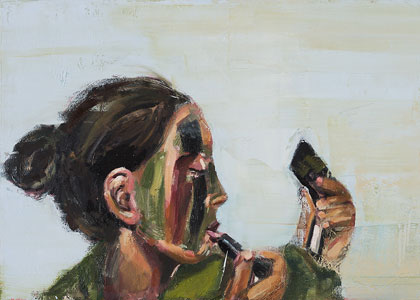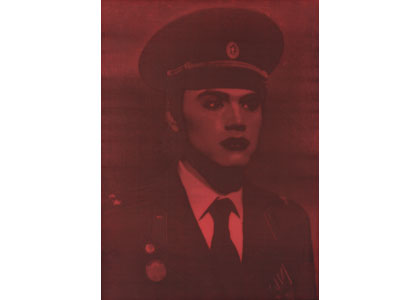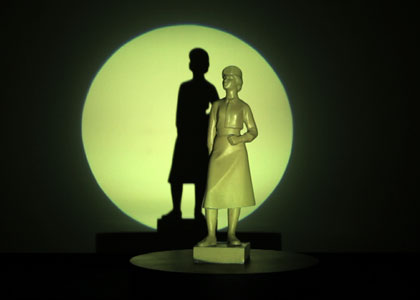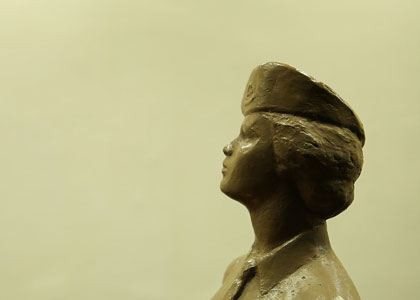superwoman
Curator: Sigal Kehat Krinski
24/04/2015 -
20/06/2015

The exhibition points at the transformation in the image of the woman soldier, as it is reflected in Israeli art from the establishment of the state to today. While the military and its values continue to assume a central place in Israeli life, the role of women in the mechanism that carries out these values is a subject that is rarely addressed. Women in the military enter the public discourse usually as extreme cases: as those who achieve the exceptional (like navigators and pilots) or alternatively, as victims of inequality or discrimination.
The complexity inherent to the depictions of the woman soldier is particularly conspicuous compared with the conventional portrayals of women in Israeli artworks from the 1940s and 1950s, which highlight “manifestly” feminine aspects. Thus, in the painting of Israel Paldi Independence, the place of the woman soldier is almost as important as the male soldier’s at the center of the composition, holding her weapon at his side, as a full partner in the pioneer-military cycle of life that the painter presents us with. In the 1950s sculpture Dafna the Palmach Fighter, displayed permanently in the Beit Yad Labanim memorial space, one can see the transition of the woman-warrior to the fore as the focus of the artwork. The sculpture creates tension between the heroic stance and rifle held high and the signs of young femininity that “slip” through the masculine representation. The sculpture was featured in the film Exodus, where it stood at the center of the fictional kibbutz “Gan Dafna”, like a monument to the young woman who was in love with the film’s protagonist, Ari Ben Canaan, and was brutally murdered. In the film excerpt featured in the exhibition, the figure of the new immigrant Karen echoes the femininity of Dafna the mythical warrior, with her golden loose hair that gives her an air of foreignness and femininity, contrasted with the somewhat Spartan look of kibbutz natives, and hints at a possibility of a life outside of the collective, pioneering, fighting order1.
In photographs from the 1950s and 1960s, we find “classic” qualities attributed to women, attached to the portrayals of women soldiers, who are represented as daughter, big sisters and even mothers. In a photograph by Alex Gal from the 1950s, a soldier is holding a crying baby, as though cast in the role of the big sister who has to bring toddlers into the military-civilian social order of young Israel. In contrast, Moshe Milner emphasizes the youthful/boyish quality of the soldier, photographed while writing a letter using a helmet as a makeshift support. Here too a fair strand of hair that escapes the meticulous hairstyle serves as a reminder that she is a soldier as well as a girl, meaning, she is still her parents’ daughter, and so also “our” daughter.
The tension between images considered feminine and the military, essentially masculine, order is apparent in the outlook of contemporary artists who address the figure of the woman soldier. The large scale painting by Anna Fromchenko embodies a touch of that fantasy of erasing the differences between the sexes in the military. The artist “seats” Major General Orna Barbivai, who was the first woman major general in IDF, at the center of a composition that quotes a portrait of a general painted by Francisco Goya (which he later painted over). In homage to Goya’s erased painting, Fromchenko named the work The Disappearing Major General, as a reminder that Barbivai “disappeared” from the military landscape after only three years in office. Ofri Marom depicts her daughter, who is fighting in Gaza during the Protective Edge war, with her face covered with camouflage paint like a soldier going on a mission. Like the masking of the face, so are the uniforms covering the body: every denial and concealment are intrinsic to the military discipline. Are we facing an image of femininity that glimpses though that “equal” discipline2, or rather one that is silenced and squashed under the masculine order?
The aspiration for gender equality, the fantasy of a world beyond the fixation of gender identity and with it the denial and concealment are also expressed in Nir Hod’s work Last Letters to Anna (1997), and the work of Efrat Gal Shanna Tova (2011). Hod presents a self portrait of sorts in the image of a soldier-pilot, highlighting the “dress up” aspect of the uniform. The visual control that strives to unify the external appearance is manifest in the officer’s cap, decorations, and tie, however, it cannot conceal the “officer’s” full lips which are painted with lipstick. Another gender reversal is found in Gal’s work, where the figure of a soldier look as though she is about to throw a hand grenade at the viewers, and below the image, the caption: “May it be Your will, Lord our God and God of our forbears, that our merits increase like the seeds of a pomegranate”, a blessing said on Rosh Hashanah dinner. The juxtaposition of the two meanings of the Hebrew word Rimon (pomegranate and hand grenade) undermines the pomegranate as a traditional symbol of fecundity (and by implication – of femininity). This is an original example to Michel Foucault’s assertion that “where there are modes of power and control, in principle one can place foci of subversion, resistance and criticism3.”
Orit Ishay’s film Serial Number 2953 focuses on the sculpture of the woman soldier created by Shimon Fogelman in 1960. The sculpture rotates on a platform in slow motion but is not displayed in full: the limbs of the sculpture emerge from soft darkness bit by bit, enveloping it in an almost erotic air. The examination of the female body is interrupted occasionally by glimpses of IDF archive photographs that document military parades and films about the role of woman soldier. The film underscores the dialogue between the private (feminine, concealed) body and its uniform representation in the collective military space: our gaze shifts back and forth between the sculpture of the soldier as an individual woman and the soldier as one of many, marching with clenched fists in a rigid military parade, which one might see as a distinct example of “the visual presentation of the regulated array of instruments applied to the human body in the aim of making the power relations obvious”4.
Alongside this work, Hagar Shapira’s installation Superwoman (2014) provides us with a contemporary outlook that seems to take into account the transformations in the figure of the woman soldier. A fan that spins in the work’s lower half inflates a skirt that opens like a big parachute in its top part, while a helicopter’s propeller is heard in the background. This seems like an abstract expression of the struggle between masculine force and feminine presence. However, while the propeller, supposedly the representative of militarism, “lifts up the skirt”, the latter spins round and round and does not succumb. Thus, in a tense equilibrium between opposing powers, they both join the fantasy of military gender equality.
And so, it looks as though the Israeli society has reached an era when this vision of gender equality is realized – of all places – in the masculine military order. We often boast about women fighter pilots, the modern descendants of Dafna the Palmach fighter. However, today there is a particular urgency to the question of the feminine element, and what happens to feminine power when it enters the masculine order that demands of it to erase the difference, and on the other hand cannot prevent the slippage of the “feminine” from under the cap, like a wayward strand of hair5.
1One could claim that the erotic dimension exists to some degree in all representations of women (and indeed male) soldiers, since any ban, distance, concealment and absence – are attached to desire. The same applies to military discipline: the desire mechanism is intrinsic to all practices that the army applies to the body, like the uniform, hairstyle, and ceremonious movements of the body, which establish the tension between the “military” and the “feminine”. According to Roland Barthes, it is also the site of the mechanism of erotic intensification – the in-between (between the concealed and the visible, between one body part and another) is the most erotic place in the body, like the skin flashing through the open-necked shirt. See Chava Brownfield-Stein, Fantasy of the State Photographs ofIDF Female Soldiers and the Eroticization of Civil Militarism in Israel , Tel Aviv: Resling, 2012; Roland Barthes, The Pleasures of the Text/Variations on Writing, Tel Aviv: Resling, 2004, p. 14; Itzhak Benyamini and Idan Zivoni (ed.), Slave, Enjoyment, Master − On Sadism and Masochism in Psychoanalysis and in Cultural Studies, Tel Aviv: Resling, 2002, p. 151. 2Colonel Ardant Du-Picq, Battle Studies, Trans. John Greely and Robert C. Cotton, New York: Macmillan, 1920.3Michel Foucault, Hetrotopia, Tel Aviv: Resling, 2003, p. 47.5Michel Foucault, Discipline and Punish – The Birth of the Prison, Trans. Alan Sheridan, New York: Pantheon Books, 1977, 29.5We could go as far as claiming that in the military context, long hair is “unrestrained sexuality” whereas “short or tied back hair [symbolizes] restrained sexuality”. See Edmund Leach, “Magical Hair”, 1958, Man 88, 154.
Works from the right:
1. Unknown photographer, Woman Soldier in the Women’s Corps, 1/3/1955, courtesy of the Oded Yarkoni Petach Tikva History Archive, Government Press Office
2. Moshe Milner, The Recruit Dalya Writes a Letter Home to Kibbutz Neot Mordechai from the Training Field , 1/3/1955, courtesy of the Oded Yarkoni Petach Tikva History Archive, Government Press Office
3. Alex Gal, “And more from the Maabara, don’t cry child, don’t cry”, 1950s, courtesy of the Oded Yarkoni Petach Tikva History Archive
4. Orit Ishay, Serial Number 2953, 2015, video, 4:00. Directed & Produced: Orit Ishay, Cinematographer: Avner Shahaf, Lighting: Nir Rachmin, Music: Adam Ben Nun, Editing: Gal Katzir, Archive Footage: IDF and Defense Establishment Archives; Herzlyia Studios, United Studios LTD.
5. Nir Hod, Last Letters to Anna, 1997, mixed media on canvas, Doron Sebbag Collection ORS LTD, Tel Aviv
6. Ofri Marom, Soldier, 2014, oil on canvas, courtesy of the artist
7. Anna Fromchenko, The Disappearing Major General, 2014, mixed media on canvas, courtesy of the artist
8. Aharon Giladi, Four Women (Grief), undated, ink and pencil on paper, collection of the Petach Tikva Museum of Art
9. Efrat Gal, Shanna Tova , 2011, pencil on paper, courtesy of the artist
10. Aharon Giladi, Goodbye to a Soldier, early 1950s, ink and gouache on paper, collection of the Petach Tikva Museum of Art
11. Two excerpts from the film Exodus, part 1: 01:20:00-01:24:00, part 2 00:31:08-00:29-30. Director: Otto Preminger, 1961, courtesy of MGM
12. Aharon Giladi, Woman, (on the back: The Upright Mother), undated, ink and pencil on paper, collection of the Petach Tikva Museum of Art
13. Israel Paldi, Independence, late-1940s, oil on canvas, collection of the Petach Tikva Museum of Art
14. (At the center) Hagar Shapira, Superwoman, 2014, installation: skirt construction, fan, wooden block, grip and sound, courtesy of the artist




